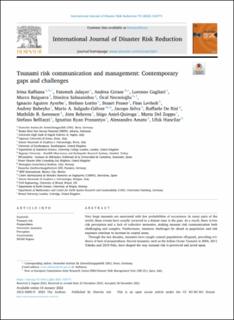| dc.contributor.author | Rafliana, Irina | |
| dc.contributor.author | Jalayer, Fatemeh | |
| dc.contributor.author | Cerase, Andrea | |
| dc.contributor.author | Cugliari, Lorenzo | |
| dc.contributor.author | Baiguera, Marco | |
| dc.contributor.author | Salmanidou, Dimitra | |
| dc.contributor.author | Necmioglu, Öcal | |
| dc.contributor.author | Aguirre-Ayerbe, Ignacio | |
| dc.contributor.author | Lorito, Stefano | |
| dc.contributor.author | Fraser, Stuart | |
| dc.contributor.author | Løvholt, Finn | |
| dc.contributor.author | Babeyko, Andrey | |
| dc.contributor.author | Salgado-Gálvez, Mario A. | |
| dc.contributor.author | Selva, Jacopo | |
| dc.contributor.author | De Risi, Raffaele | |
| dc.contributor.author | Sørensen, Mathilde Bøttger | |
| dc.contributor.author | Behrens, Jörn | |
| dc.contributor.author | Aniel-Quiroga, Iñigo | |
| dc.contributor.author | Del Zoppo, Marta | |
| dc.contributor.author | Belliazzi, Stefano | |
| dc.contributor.author | Pranantyo, Ignatius Ryan | |
| dc.contributor.author | Amato, Alessandro | |
| dc.contributor.author | Hancilar, Ufuk | |
| dc.date.accessioned | 2022-06-03T12:04:59Z | |
| dc.date.available | 2022-06-03T12:04:59Z | |
| dc.date.created | 2022-01-27T15:53:37Z | |
| dc.date.issued | 2022 | |
| dc.identifier.issn | 2212-4209 | |
| dc.identifier.uri | https://hdl.handle.net/11250/2997528 | |
| dc.description.abstract | Very large tsunamis are associated with low probabilities of occurrence. In many parts of the world, these events have usually occurred in a distant time in the past. As a result, there is low risk perception and a lack of collective memories, making tsunami risk communication both challenging and complex. Furthermore, immense challenges lie ahead as population and risk exposure continue to increase in coastal areas.
Through the last decades, tsunamis have caught coastal populations off-guard, providing evidence of lack of preparedness. Recent tsunamis, such as the Indian Ocean Tsunami in 2004, 2011 Tohoku and 2018 Palu, have shaped the way tsunami risk is perceived and acted upon.
Based on lessons learned from a selection of past tsunami events, this paper aims to review the existing body of knowledge and the current challenges in tsunami risk communication, and to identify the gaps in the tsunami risk management methodologies. The important lessons provided by the past events call for strengthening community resilience and improvement in risk-informed actions and policy measures.
This paper shows that research efforts related to tsunami risk communication remain fragmented. The analysis of tsunami risk together with a thorough understanding of risk communication gaps and challenges is indispensable towards developing and deploying comprehensive disaster risk reduction measures. Moving from a broad and interdisciplinary perspective, the paper suggests that probabilistic hazard and risk assessments could potentially contribute towards better science communication and improved planning and implementation of risk mitigation measures. | en_US |
| dc.language.iso | eng | en_US |
| dc.publisher | Elsevier | en_US |
| dc.rights | Attribution-NonCommercial-NoDerivatives 4.0 Internasjonal | * |
| dc.rights.uri | http://creativecommons.org/licenses/by-nc-nd/4.0/deed.no | * |
| dc.title | Tsunami risk communication and management: Contemporary gaps and challenges | en_US |
| dc.type | Journal article | en_US |
| dc.type | Peer reviewed | en_US |
| dc.description.version | publishedVersion | en_US |
| dc.rights.holder | © 2022 The Authors. | en_US |
| dc.source.articlenumber | 102771 | en_US |
| cristin.ispublished | true | |
| cristin.fulltext | original | |
| cristin.qualitycode | 1 | |
| dc.identifier.doi | 10.1016/j.ijdrr.2021.102771 | |
| dc.identifier.cristin | 1991614 | |
| dc.source.journal | International Journal of Disaster Risk Reduction | en_US |
| dc.identifier.citation | International Journal of Disaster Risk Reduction. 2022, 70:102771. | en_US |
| dc.source.volume | 70 | en_US |
| dc.source.issue | 15 | en_US |

